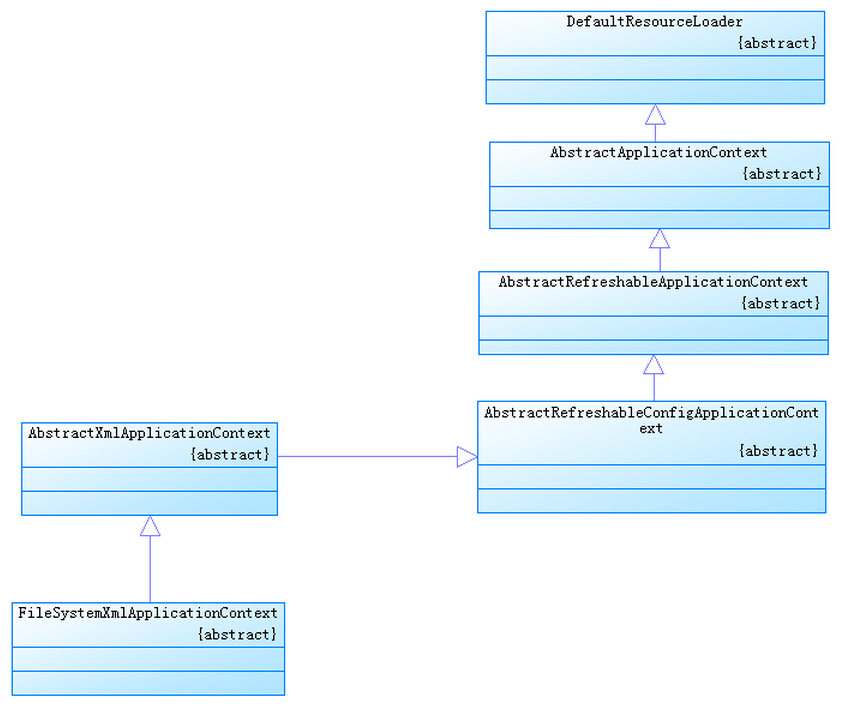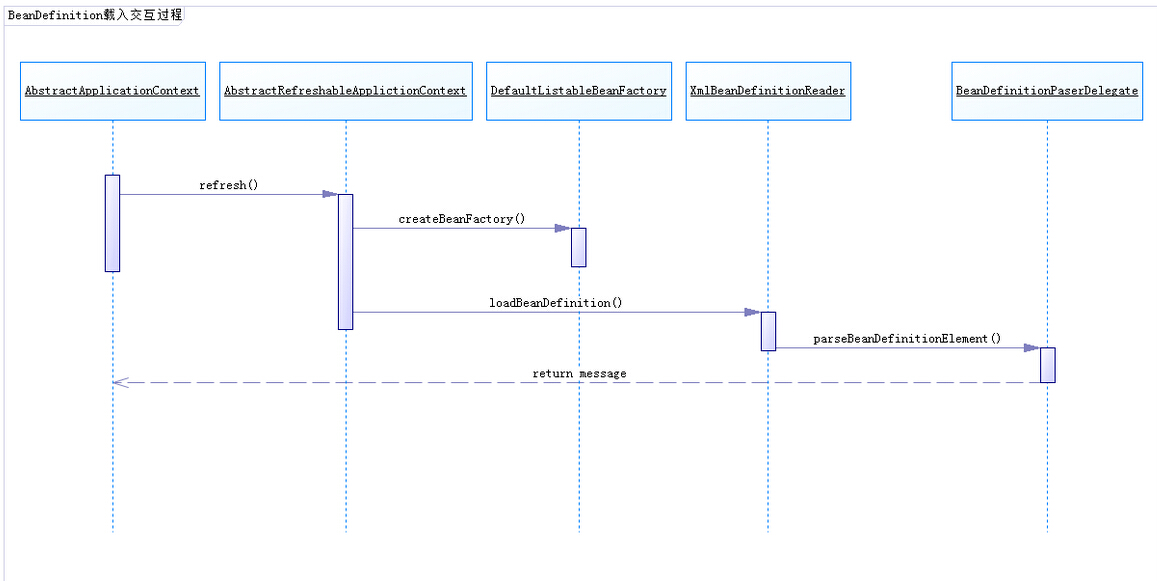三、IOC容器的初始化过程
IOC容器的初始化时由前面介绍的refresh方法来启动的,这个方法标志着IOC容器的正式启动。这个启动包括BeanDefinition的Resource定位、载入和注册。下面我们将详细分析这三个实现过程,Spring把这三个过程分开,并使用不同的模块来完成,通过这样的设计让用户更加灵活的这三个过程进行剪裁和扩展,定义出最适合自己的IOC容器的初始化过程。
第一个过程:
Resource定位过程,是指BeanDefinition的资源定位,他由ResourceLoader通过统一的Resource接口来完成,这个Resource对各种形式的BeanDefinition的使用都提供了统一的接口。比如,在文件系统中的Bean定义信息可以使用FileSystemResource来进行抽象,在类路径中的Bean定义信息可以使用前面提到的ClassPathResource来使用,这个定位过程类似于容器寻找数据的过程,就像水桶装水先要找到水。
第二个过程:
BeanDefinition的载入,这个过程是把用户定义好的Bean表示成IOC容器内部数据结构,而这个容器内部的数据结构就是BeanDefinition。具体来说,这个BeanDefinition实际上就是POJO对象在IOC容器中的抽象,通过这个BeanDefinition定义的数据结构,使IOC容器能够方便的对POJO对象也就是Bean进行管理。
第三个过程:
向IOC容器注册这些BeanDefinition的过程。通过调用BeanDefinitionRegistry接口的实现来完成。这个注册过程把载入过程中解析得到的BeanDefinition向IOC容器进行注册。通过分析,在IOC容器内部将BeanDefinition注入到一个HashMap中去,IOC容器就是通过IOC容器的初始化过程来持有这些BeanDefinition数据的。
说明:这里说的IOC容器初始化过程,一般不包含Bean依赖注入的实现。在Spring的IOC设计中,Bean的定义载入和依赖注入是两个独立的过程。依赖注入一般发生在应用第一次通过getBean向容器索取Bean的时候。但有一个例外值得注意,在使用IOC容器设计时有一个预实例化的配置,通过这个配置(为bean定义信息中的lazyinit属性),用户可以对容器初始化过程作一个微笑的控制,从而改变这个被设置了lazyinit属性的Bean的依赖注入。举例来说,如果我们对某个Bean设置了lazyinit属性,那个这个Bean的依赖注入在IOC容器初始化时就预先完成了,而不需要等到整个初始化完成之后。
1、BeanDefinition的Resource定位
首先看下面一行代码:
ClassPathResource res = new ClassPathResource("benas.xml");这里定义的Resource并不能直接由DefaultListableBeanFactory直接使用,Spring通过BeanDefinitionReader来对这些信息进行处理。在这里我们可以看到使用ApplicationContext相对于直接使用DefaultListableBeanFactory的好处。在ApplicationContext中,Spring已经为我们提供了一系列的加载不同Resource的读取器的实现,而DefaultListableBeanFactory只是一个纯粹的IOC容器,需要为他配置特定的读取器才能完成这些功能。当然,有利有弊,使用DefaultListableBeanFactory这种更底层的容器能提高定制IOC容器的灵活性。
回到ApplicationContext上来,例如FileSystemXMLApplicationContext、ClassPathXMLApplicationContext以及XMLWebApplicationContext等。简单的从这些类名字就看到他们可以提供哪些不同的Resource读入功能。
下面以FileSystemXMLApplicationContext为例,分析ApplicationContext的实现怎样完成Resource的定位过程

下面让我看下FileSystemXMLApplicationContext的具体实现:
/**
* Standalone XML application context, taking the context definition files
* from the file system or from URLs, interpreting plain paths as relative
* file system locations (e.g. "mydir/myfile.txt"). Useful for test harnesses
* as well as for standalone environments.
* 独立的XML应用程序上下文,以上下文定义文件
* <p><b>NOTE:</b> Plain paths will always be interpreted as relative
* to the current VM working directory, even if they start with a slash.
* (This is consistent with the semantics in a Servlet container.)
* <b>Use an explicit "file:" prefix to enforce an absolute file path.</b>
*
* <p>The config location defaults can be overridden via {@link #getConfigLocations},
* Config locations can either denote concrete files like "/myfiles/context.xml"
* or Ant-style patterns like "/myfiles/*-context.xml" (see the
* {@link org.springframework.util.AntPathMatcher} javadoc for pattern details).
*
* <p>Note: In case of multiple config locations, later bean definitions will
* override ones defined in earlier loaded files. This can be leveraged to
* deliberately override certain bean definitions via an extra XML file.
*
* <p><b>This is a simple, one-stop shop convenience ApplicationContext.
* Consider using the {@link GenericApplicationContext} class in combination
* with an {@link org.springframework.beans.factory.xml.XmlBeanDefinitionReader}
* for more flexible context setup.</b>
*
* @author Rod Johnson
* @author Juergen Hoeller
* @see #getResource
* @see #getResourceByPath
* @see GenericApplicationContext
*/
public class FileSystemXmlApplicationContext extends AbstractXmlApplicationContext {
/**
* Create a new FileSystemXmlApplicationContext for bean-style configuration.
* @see #setConfigLocation
* @see #setConfigLocations
* @see #afterPropertiesSet()
*/
public FileSystemXmlApplicationContext() {
}
/**
* Create a new FileSystemXmlApplicationContext for bean-style configuration.
* @param parent the parent context
* @see #setConfigLocation
* @see #setConfigLocations
* @see #afterPropertiesSet()
*/
public FileSystemXmlApplicationContext(ApplicationContext parent) {
super(parent);
}
/**
* Create a new FileSystemXmlApplicationContext, loading the definitions
* from the given XML file and automatically refreshing the context.
* @param configLocation file path
* @throws BeansException if context creation failed
* 这个构造函数的configLocation包含的是BeanDefinition所在的文件路径
*/
public FileSystemXmlApplicationContext(String configLocation) throws BeansException {
this(new String[] {configLocation}, true, null);
}
/**
* Create a new FileSystemXmlApplicationContext, loading the definitions
* from the given XML files and automatically refreshing the context.
* @param configLocations array of file paths
* @throws BeansException if context creation failed
* 这个构造函数允许configLocation包含多核BeanDefinition的文件路径
*/
public FileSystemXmlApplicationContext(String... configLocations) throws BeansException {
this(configLocations, true, null);
}
/**
* Create a new FileSystemXmlApplicationContext with the given parent,
* loading the definitions from the given XML files and automatically
* refreshing the context.
* @param configLocations array of file paths
* @param parent the parent context
* @throws BeansException if context creation failed
* 这个构造函数在允许configLocation包含多个BeanDefinition的文件路径同时,还允许指定自己的双亲IOC容器
*/
public FileSystemXmlApplicationContext(String[] configLocations, ApplicationContext parent) throws BeansException {
this(configLocations, true, parent);
}
/**
* Create a new FileSystemXmlApplicationContext, loading the definitions
* from the given XML files.
* @param configLocations array of file paths
* @param refresh whether to automatically refresh the context,
* loading all bean definitions and creating all singletons.
* Alternatively, call refresh manually after further configuring the context.
* @throws BeansException if context creation failed
* @see #refresh()
*/
public FileSystemXmlApplicationContext(String[] configLocations, boolean refresh) throws BeansException {
this(configLocations, refresh, null);
}
/**
* Create a new FileSystemXmlApplicationContext with the given parent,
* loading the definitions from the given XML files.
* @param configLocations array of file paths
* @param refresh whether to automatically refresh the context,
* loading all bean definitions and creating all singletons.
* Alternatively, call refresh manually after further configuring the context.
* @param parent the parent context
* @throws BeansException if context creation failed
* @see #refresh()
* 在对象初始化过程中,调用refresh函数载入BeanDefinition,这个refresh启动了BeanDefinition的载入过程
*/
public FileSystemXmlApplicationContext(String[] configLocations, boolean refresh, ApplicationContext parent)
throws BeansException {
super(parent);
setConfigLocations(configLocations);
if (refresh) {
refresh();
}
}
/**
* Resolve resource paths as file system paths.
* <p>Note: Even if a given path starts with a slash, it will get
* interpreted as relative to the current VM working directory.
* This is consistent with the semantics in a Servlet container.
* @param path path to the resource
* @return Resource handle
* @see org.springframework.web.context.support.XmlWebApplicationContext#getResourceByPath
* 这是应用于文件系统中Resource的实现,通过构造一个FileSystemResource来得到一个在文件系统中定位的BeanDefinition
* 这个getResourceByPath是在BeanDefinitionReader的loadBeanDefintion中被调用的
* loadBeanDefintion采用了模板模式,具体的定位实现实际上是由各个子类来完成的
*/
@Override
protected Resource getResourceByPath(String path) {
if (path != null && path.startsWith("/")) {
path = path.substring(1);
}
return new FileSystemResource(path);
}
}getResourceByPath方法是一个模板方法,是为读取Resource服务的。对于IOC容器的功能实现这里没有涉及,因为他继承了AbstractXMLApplicationContext,关于IOC容器的功能相关实现都是在FileSystemXMLApplicationContext中完成的,但是在构造函数中通过refresh来东IOC容器的初始化,这个refresh方法非常重要,这也是以后分析容器初始化过程实现的一个重要入口。
在IOC容器的初始化过程中,BeanDefinition资源的定位、读入和注册过程是分开进行的,这也是一个解耦的体现。关于读入的配置,可以到FileSystemXMLApplicationContext的基类AbstractRefreshableApplicationContext中看看怎么实现:
/**
* This implementation performs an actual refresh of this context's underlying
* bean factory, shutting down the previous bean factory (if any) and
* initializing a fresh bean factory for the next phase of the context's lifecycle.
*/
@Override
protected final void refreshBeanFactory() throws BeansException {
// 这里判断如果已经建立了BeanFactory,则销毁并关闭BeanFactory
if (hasBeanFactory()) {
destroyBeans();
closeBeanFactory();
}
// 这里是创建并设置持有的DefaultListableBeanFactory的地方,同时调用loadBeanDefinition再载入BeanDefinition
try {
DefaultListableBeanFactory beanFactory = createBeanFactory();
beanFactory.setSerializationId(getId());
customizeBeanFactory(beanFactory);
loadBeanDefinitions(beanFactory);
synchronized (this.beanFactoryMonitor) {
this.beanFactory = beanFactory;
}
}
catch (IOException ex) {
throw new ApplicationContextException("I/O error parsing bean definition source for " + getDisplayName(), ex);
}
}/**
* Create an internal bean factory for this context.
* Called for each {@link #refresh()} attempt.
* <p>The default implementation creates a
* {@link org.springframework.beans.factory.support.DefaultListableBeanFactory}
* with the {@linkplain #getInternalParentBeanFactory() internal bean factory} of this
* context's parent as parent bean factory. Can be overridden in subclasses,
* for example to customize DefaultListableBeanFactory's settings.
* @return the bean factory for this context
* @see org.springframework.beans.factory.support.DefaultListableBeanFactory#setAllowBeanDefinitionOverriding
* @see org.springframework.beans.factory.support.DefaultListableBeanFactory#setAllowEagerClassLoading
* @see org.springframework.beans.factory.support.DefaultListableBeanFactory#setAllowCircularReferences
* @see org.springframework.beans.factory.support.DefaultListableBeanFactory#setAllowRawInjectionDespiteWrapping
* 这就是在上下文中创建DefaultListableBeanFactory地方,而getInsternalParentBeanFactory(),具体实现可以参见
* AbstractApplicationContext中的实现,会根据容器已有的双亲IOC容器信息来生成DefaultListableBeanFactory
* 的双亲IOC容器
*/
protected DefaultListableBeanFactory createBeanFactory() {
return new DefaultListableBeanFactory(getInternalParentBeanFactory());
}/**
* Load bean definitions into the given bean factory, typically through
* delegating to one or more bean definition readers.
* @param beanFactory the bean factory to load bean definitions into
* @throws BeansException if parsing of the bean definitions failed
* @throws IOException if loading of bean definition files failed
* @see org.springframework.beans.factory.support.PropertiesBeanDefinitionReader
* @see org.springframework.beans.factory.xml.XmlBeanDefinitionReader
* 这就是使用BeanDefinitionReader载入Bean定义的地方,因为允许有多种载入方式,虽然用的最多的是XML
* 通过一个抽象函数把具体的实现委托给子类来完成
*/
protected abstract void loadBeanDefinitions(DefaultListableBeanFactory beanFactory)
throws BeansException, IOException;/**
* Load bean definitions from the specified resource location.
* <p>The location can also be a location pattern, provided that the
* ResourceLoader of this bean definition reader is a ResourcePatternResolver.
* @param location the resource location, to be loaded with the ResourceLoader
* (or ResourcePatternResolver) of this bean definition reader
* @param actualResources a Set to be filled with the actual Resource objects
* that have been resolved during the loading process. May be {@code null}
* to indicate that the caller is not interested in those Resource objects.
* @return the number of bean definitions found
* @throws BeanDefinitionStoreException in case of loading or parsing errors
* @see #getResourceLoader()
* @see #loadBeanDefinitions(org.springframework.core.io.Resource)
* @see #loadBeanDefinitions(org.springframework.core.io.Resource[])
*/
public int loadBeanDefinitions(String location, Set<Resource> actualResources) throws BeanDefinitionStoreException {
// 这里取得ResourceLoader,使用的是DefaultResourceLoader
ResourceLoader resourceLoader = getResourceLoader();
if (resourceLoader == null) {
throw new BeanDefinitionStoreException(
"Cannot import bean definitions from location [" + location + "]: no ResourceLoader available");
}
// 这里对Resource的路径模式进行解析,比如我们设定的各种Ant格式的路径定义,得到需要的Resource集合
// 这些Resource集合指向我们已经定义好的BeanDefinition信息,可以是多个文件
if (resourceLoader instanceof ResourcePatternResolver) {
// Resource pattern matching available.
try {
// 调用DefaultResourceLoader的getResource完成具体的Resource定位
Resource[] resources = ((ResourcePatternResolver) resourceLoader).getResources(location);
int loadCount = loadBeanDefinitions(resources);
if (actualResources != null) {
for (Resource resource : resources) {
actualResources.add(resource);
}
}
if (logger.isDebugEnabled()) {
logger.debug("Loaded " + loadCount + " bean definitions from location pattern [" + location + "]");
}
return loadCount;
}
catch (IOException ex) {
throw new BeanDefinitionStoreException(
"Could not resolve bean definition resource pattern [" + location + "]", ex);
}
}
else {
// Can only load single resources by absolute URL.
// 调用DefaultResourceLoader的getResource完成具体的Resource定位
Resource resource = resourceLoader.getResource(location);
int loadCount = loadBeanDefinitions(resource);
if (actualResources != null) {
actualResources.add(resource);
}
if (logger.isDebugEnabled()) {
logger.debug("Loaded " + loadCount + " bean definitions from location [" + location + "]");
}
return loadCount;
}
}对于Resource的具体过程,我们可以看看DefaultResourceLoader是怎样完成的
public Resource getResource(String location) {
Assert.notNull(location, "Location must not be null");
// 这里处理带有classpath标识的Resource
if (location.startsWith(CLASSPATH_URL_PREFIX)) {
return new ClassPathResource(location.substring(CLASSPATH_URL_PREFIX.length()), getClassLoader());
}
else {
try {
// Try to parse the location as a URL...
// 这里处理URL标识的Resource定位
URL url = new URL(location);
return new UrlResource(url);
}
catch (MalformedURLException ex) {
// No URL -> resolve as resource path.
// 如果既不是classpath也是URL标识的Resource定位,则吧getResource的重任交给
// getResourceByPath,这个方法时一个protected,默认的实现是得到一个ClassPathContextResource
// 这个方法常常会用子类来实现
return getResourceByPath(location);
}
}
}下面我们来看看getResourceByPath的实现
/**
* Resolve resource paths as file system paths.
* <p>Note: Even if a given path starts with a slash, it will get
* interpreted as relative to the current VM working directory.
* This is consistent with the semantics in a Servlet container.
* @param path path to the resource
* @return Resource handle
* @see org.springframework.web.context.support.XmlWebApplicationContext#getResourceByPath
*/
@Override
protected Resource getResourceByPath(String path) {
if (path != null && path.startsWith("/")) {
path = path.substring(1);
}
return new FileSystemResource(path);
}如果是其他的ApplicationContext,那么会对应生成其他种类的Resource,比如ClassPathResource、ServletContextResource。
在BeanDefinition定位完成的基础上,就可以通过返回的Resource对象来进行BeanDefinition的载入了。在定位过程完成以后,为BeanDefinition的载入创造了I/O操作的条件,但是具体的数据还没有开始读入。这些数据的读入将在下面介绍BeanDefinition的载入和解析中来完成。仍然以水桶为例子,这里就到了就像用水桶去打水,要先找到水源。这里完成对Resource定位,就类似于水源已经找到了,下面就是打水的过程了,类似于把找到的水装到水桶里面。找水不简单,但是与打水相比,打水更需要技巧。
2、BeanDefinition的载入和解析
在IOC容器来说,载入过程相当于把定义的BeanDefinition在IOC容器中转化为一个Spring内部表示的数据结构的过程。IOC容器对Bean的管理和依赖注入功能的实现,是通过对其持有的BeanDefinition进行各种相关操作来完成的。zhexieBeanDefinition的数据在IOC容器中通过一个HashMap来保持好和维护。当然这只是一种比较简单的维护方式,如果需要提高IOC容器的性能和容量,完全可以自己做一些扩展。
下面从DefaultListableBeanFactory的设计入手,看看IOC容器是怎么样完成BeanDefinition载入的。在开始分析之前,先回到IOC容器的初始化入口,也就是看一下refresh方法,这个方法的最初是在FileSystemXMLApplicationContext的构造函数中被调用的,他的调用标识着容器初始化的开始,这些初始化对象就是BeanDefinition数据,初始化入口如下:
/**
* Create a new FileSystemXmlApplicationContext with the given parent,
* loading the definitions from the given XML files.
* @param configLocations array of file paths
* @param refresh whether to automatically refresh the context,
* loading all bean definitions and creating all singletons.
* Alternatively, call refresh manually after further configuring the context.
* @param parent the parent context
* @throws BeansException if context creation failed
* @see #refresh()
*/
public FileSystemXmlApplicationContext(String[] configLocations, boolean refresh, ApplicationContext parent)
throws BeansException {
super(parent);
setConfigLocations(configLocations);
if (refresh) {
refresh();
}
}对容器的启动来说,refresh是一个很重要的方法。该方法在AbstractApplicationContext类(FileSystemXMLApplicationContext的基类)。他详细的描述了整个ApplicationContext的初始化过程,比如BeanFactory的更新,MessageSource和PostProcessor的注册等。
这个IOC容器的refresh的过程代码如下:
public void refresh() throws BeansException, IllegalStateException {
synchronized (this.startupShutdownMonitor) {
// Prepare this context for refreshing.
prepareRefresh();
// Tell the subclass to refresh the internal bean factory.
// 这里是在子类中启动refreshBeanFactory的地方
ConfigurableListableBeanFactory beanFactory = obtainFreshBeanFactory();
// Prepare the bean factory for use in this context.
prepareBeanFactory(beanFactory);
try {
// Allows post-processing of the bean factory in context subclasses.
// 设置BeanFactory的后置处理
postProcessBeanFactory(beanFactory);
// Invoke factory processors registered as beans in the context.
// 调用BeanFactory的后处理器,这些后处理器是在Bean定义中向容器注册的
invokeBeanFactoryPostProcessors(beanFactory);
// Register bean processors that intercept bean creation.
// 注册Bean的后处理器,在Bean创建过程中调用
registerBeanPostProcessors(beanFactory);
// Initialize message source for this context.
// 对上下文中的消息源进行初始化
initMessageSource();
// Initialize event multicaster for this context.
// 初始化上下文中的事件机制
initApplicationEventMulticaster();
// Initialize other special beans in specific context subclasses.
// 初始化其他的特殊Bean
onRefresh();
// Check for listener beans and register them.
// 检查监听Bean,并且将这些Bean向容器注册
registerListeners();
// Instantiate all remaining (non-lazy-init) singletons.
// 实例化所有的non-lazy-init事件
finishBeanFactoryInitialization(beanFactory);
// Last step: publish corresponding event.
// 发布容器事件,结束Refresh过程
finishRefresh();
}
catch (BeansException ex) {
// Destroy already created singletons to avoid dangling resources.
// 为防止Bean资源占用,在异常处理中,销毁已经在前面生成的单件Bean
destroyBeans();
// Reset 'active' flag.
cancelRefresh(ex);
// Propagate exception to caller.
throw ex;
}
}
}进入到AbstractRefreshableApplicationContext的refreshBeanFactory方法中,在这个方法中创建了BeanFactory。在创建IOC容器前,如果已经有容器存在,那么需要把已有的容器销毁和关闭,保证在refresh以后使用的是新建立的IOC容器。这么看来,refresh非常像重启容器,就想重启计算机那样。在建立好当前的IOC容器以后,开始了对容器的初始化过程,比如BeanDefinition的载入。
下面看下refreshBeanFactory的代码:
/**
* This implementation performs an actual refresh of this context's underlying
* bean factory, shutting down the previous bean factory (if any) and
* initializing a fresh bean factory for the next phase of the context's lifecycle.
*/
@Override
protected final void refreshBeanFactory() throws BeansException {
if (hasBeanFactory()) {
destroyBeans();
closeBeanFactory();
}
try {
// 创建IOC容器,这里使用的是DefaultListableBeanFactory
DefaultListableBeanFactory beanFactory = createBeanFactory();
beanFactory.setSerializationId(getId());
customizeBeanFactory(beanFactory);
// 启动对BeanDefinition的载入
loadBeanDefinitions(beanFactory);
synchronized (this.beanFactoryMonitor) {
this.beanFactory = beanFactory;
}
}
catch (IOException ex) {
throw new ApplicationContextException("I/O error parsing bean definition source for " + getDisplayName(), ex);
}
}
未完待续……























 408
408











 被折叠的 条评论
为什么被折叠?
被折叠的 条评论
为什么被折叠?








